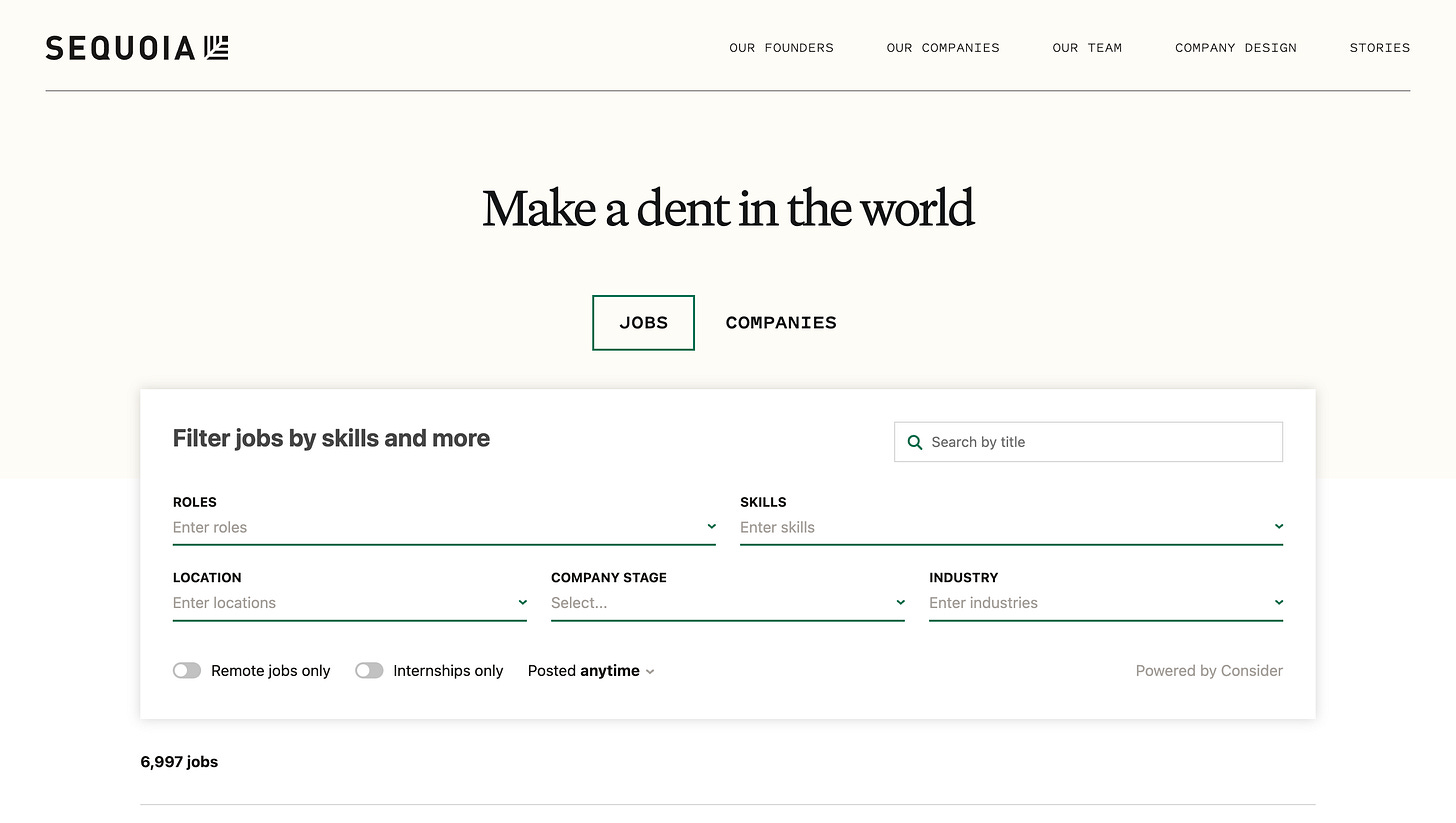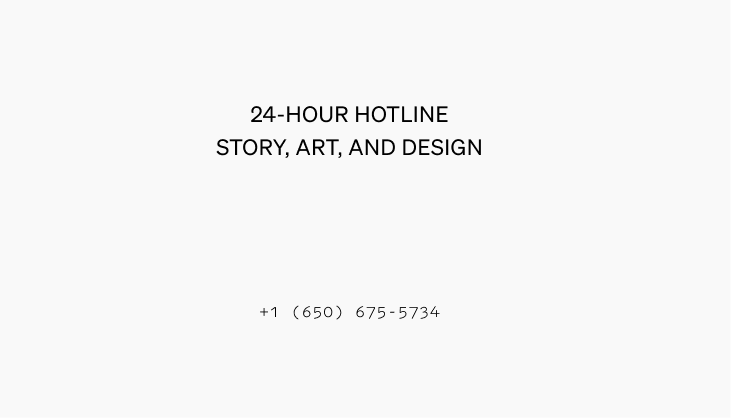How to Find a Job at a Startup
This is a hands-on, practical guide for finding a secret stash of jobs, effectively cold emailing for a warm intro, and performing your best at the interview.
Startups aren’t for everyone, but if you are interested in joining a high-risk, high-reward endeavor, here is a practical guide.
Part I — Where are the jobs?
Part II — How to turn a cold email into a warm intro
Part III — How to prepare for an interview
Part I — Where are the jobs?
You want to join a startup, but how do you know if it’s any good? Meeting the people and digging deep is the best way, but much faster and almost as good is to use Venture Capital firms as a filter to help you identify high-potential companies. Go to the websites of VCs and look for a jobs page. These won’t be for investor jobs, but instead will be listings for jobs working at the VC’s portfolio of companies. For instance, I’m the Design Partner at Sequoia. Our semi-hidden secret stash of jobs is here:
https://jobs.sequoiacap.com/jobs
The page lists thousands of jobs at Sequoia-backed or Sequoia-adjacent companies. Adjust the filters and see what you find. Explore the companies and reach out to the ones that feel like a good match.
A few VC Job Boards
Just to show that I”m not just “talking my own book” here are a few more jobs pages from other VCs. Check them out, explore what’s out there, and get a sense of the market.
Part II — How to turn a cold email into a warm intro
You can apply directly to a company, but here is a secret: The best way to apply to a job is to have a warm introduction. To do that, you need to know someone at the company or someone connected to the company.
How do you get to know someone who either works there or is connected? To do this, you have to reach out to someone. But what do you say? You can’t just say “give me a job” or “give me a warm introduction” and you wouldn’t want to… the idea is to learn if a company is a good match for you. You want figure out if this is a company, role, and environment that is where you want to work for the foreseeable future.
If you are feeling panicked, or almost desperate for a job, this will feel like a tedious, friction-filled, and almost “performative” intermediary step. But it matters. It is terrible to join something and immediately quit or get fired because it wasn’t actually a good match. It’s also terrible to have your resume thrown into the “slush pile” and never read. A warm introduction opens doors and sheds light on the company and it’s culture.
Here’s how to do it:
Map the chain
The first step is to map the chain of connections to figure out how a particular person is connected to the company and connected to you. What are her or his specific strengths and opinions and how might this person have a point of view that matters to your decision? Research to discover whether you and this person share any intellectual common ground. You should read at least three Medium, Substack, or LinkedIN long-form posts from this person and have a sense of what they think is interesting and important.
Ask them something to which they can say yes
When cold emailing someone, you only make it to the next step if they give you a “yes” so you need to design your request so that they can say yes to what you are asking. First, let’s look at failure mode:
Don’t ask: Hey you, can you give me a job?
Failure mode: (too much, too soon)
Don’t ask: “Can I pick your brain?”
Failure mode: (ewww gross, waste of time, why? to what end?).
Don’t ask: “Can I be your intern?”
Failure mode: (too much, too soon)
Do ask:
Dear James Buckhouse,
I’m researching product development in the AI era and really enjoyed the articles you wrote on Coding Backwards and MCP. I’m interested in learning more about how product and design leaders are implementing these new approaches for their teams and would like to hear more about how you are putting these ideas to work at Sequoia.
Any chance for a 15 min zoom? Why it might work: Most people can say yes to a 15 min zoom. If the zoom goes well, then maybe there’s a next step, like meeting more members of the team. Be specific about what you are asking to do “book a 15 min zoom to talk about Coding Backwards and MCP” not something vague, too much too soon, or off-putting.
Keep your email short
Don’t spill your whole story. Don’t gush. No details. Send less than 50-100 words, with 80% of those words directly related to the person you are emailing. If they don’t email back, then wait two weeks and send a draft of the research you claimed to have been working on (to show it was real) and show the blank spot in the research where you hope to gather their opinion.
Bonus Round: Do some pre-work
Here’s that same email again, but this time the sender has read three articles and followed the process of one to implement something mentioned in the other two. Notice how this one reads as something quite interesting for the recipient.
Bonus round: Do ask:
Dear James Buckhouse,
I’m researching product development in the AI era and really enjoyed the articles you wrote on Coding Backwards and MCP. Attempting to put it all together, I used your Coding Backwards approach to write my own MCP plug-in for adjusting copy inside of Figma, because, well, words matter.
I'd love to show you the plug-in and talk more about how product and design leaders are working differently in the AI era.
Any chance for a 15 min zoom? This email is very appealing to the recipient. The reader has researched, developed a new idea based on what she or he read, then did some significant work to put it all into action. The sender chose two recent articles and one classic. The sender also picked an example related to my job, in this case Figma, which is both a design tool and is in the Sequoia portfolio.
A+ no notes.
Notice how the email doesn’t brag about fancy education, past work experience, or celebrity name-dropping. Instead it demonstrates unmistakable competence. Also, now I’m interested… who is this person? I want to meet her or him. This person seems great. Was it more work to read three articles and code a plug-in? Yes, but if you’re unemployed use time as a weapon to standout.
Part III — How to prepare for an interview
You’ve nurtured a warm intro. You’ve built some intellectual common ground. You gained trust and have now been asked in for an interview… Now what?
I’ve written an extensive guide for preparing for your interview here: It includes step-by-step frameworks for building your best stories, Check it out~
Your Interview Story
This guide presents hands-on, practical advice to use story to help you get the job you want. Think of your story as a machine that helps you understand yourself (and get hired doing work you want to do).
The guide gives you story structures and techniques to present your story and your journey. When you get an interview, work through this guide to tell your best stories. It’s harder than it sounds, and more important than you think.
Also included in the article is a link to my Delphi, an AI-version of me you can call and talk to an AI-version of me to practice your story. Call anytime, 24-hours a day. It’s my AI that answers, so you are not bothering me.
Know someone looking for a job? send them this article…
You’re getting this newsletter because at some point you signed-up on my Twitter Medium LinkedIn or Insta. Think of me as your creative friend on the internet, who always tries to give you something artful, helpful, and interesting.
Got a Story, Art, or Design Emergency?
Call my 24-Hour Story, Art, and Design Hotline
and talk for free to my AI-Buckhouse Agent
+1 (650) 675-5734
Web calling here for outside the US




